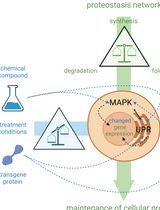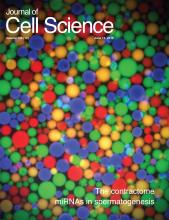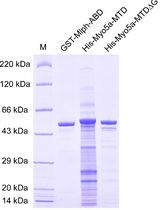- EN - English
- CN - 中文
Visible Immunoprecipitation (VIP) Assay: a Simple and Versatile Method for Visual Detection of Protein-protein Interactions
可视免疫沉淀(VIP)实验:一种简单通用的蛋白质 - 蛋白质相互作用可视化检测方法
发布: 2018年01月05日第8卷第1期 DOI: 10.21769/BioProtoc.2687 浏览次数: 13401
评审: Alessandro DidonnaLai-Yee WongMirko Messa

相关实验方案

Cell-Sonar:通过特定蛋白标志物表达变化追踪目标蛋白的简便低成本方法
Sabrina Brockmöller [...] Simone Rothmiller
2025年02月05日 1525 阅读
Abstract
The visible immunoprecipitation (VIP) assay is a convenient alternative to conventional co-immunoprecipitation (Katoh et al., 2015). By processing lysates from cells co-expressing GFP-fusion and RFP-fusion proteins for immunoprecipitation with GST-tagged anti-GFP Nanobody and glutathione-Sepharose beads, protein-protein interactions can be visualized by directly observing the beads bearing immunoprecipitates under a fluorescence microscope. This assay can examine a large number of protein combinations at one time, without requiring time-consuming procedures, including SDS-PAGE and immunoblotting. Furthermore, the VIP assay can examine complicated one-to-many and many-to-many protein interactions. Another important point of the VIP assay is the use of nanobodies for immunoprecipitation. A Nanobody is a single-domain antibody derived from Camelidae (camels and relatives). Because of its small size, high-affinity, high-specificity, and stability, anti-GFP Nanobody expressed in E. coli can be purified on a large scale, and used virtually inexhaustibly for immunoprecipitation experiments. Here we describe protocols for preparation of GST-tagged anti-GFP Nanobody and the VIP assay.
Keywords: Visible immunoprecipitation (VIP) (可视免疫沉淀(VIP))Background
Almost all proteins in cells function by interacting with other proteins. Revealing the protein-protein interaction network is the key to understand the functions of the proteins. Various methods such as yeast two-hybrid system, GST pull-down, and co-immunoprecipitation have been developed to analyze protein-protein interactions. Recently, we have developed a new method for protein-protein interaction analysis called visible immunoprecipitation (VIP) assay (Katoh et al., 2015). The most important advantage of VIP assay is that it is handy and convenient. This assay can examine a large number of protein combinations in a short time, without requiring time-consuming procedures, including SDS-PAGE and immunoblotting. Furthermore, the VIP assay can determine interactions between more than two proteins at a time. This powerful tool can be used to reveal the intricate architectures of multi-protein complexes, which cannot be determined by conventional protein-protein interaction assays. By taking advantage of the VIP assay, we have elucidated architectures of multi-subunit complexes, the BBSome (composed of 8 subunits) (Katoh et al., 2015), IFT-B (16 subunits) (Katoh et al., 2016), and IFT-A (6 subunits) (Hirano et al., 2017), all of which are involved in protein trafficking within the cilia.
Materials and Reagents
- 10 ml test tubes (ASIA KIZAI, catalog numbers: 2221C010B-10 )
- 50 ml tubes (Thermo Fisher Scientific, Thermo ScientificTM, catalog number: 339652 )
- 15 ml tubes (Thermo Fisher Scientific, Thermo ScientificTM, catalog number: 339650 )
- 6-well plates (Thermo Fisher Scientific, Thermo ScientificTM, catalog number: 140675 )
- 1.5 ml tubes (BIO-BIK, catalog number: RC-0150 )
- 0.2 ml 8-Tube Strips (Greiner Bio One International, catalog numbers: 673210 and 373270 )
- 96-well plate (Thermo Fisher Scientific, Thermo ScientificTM, catalog number: 167008 )
- 0.22 µm PVDF filter (Millex-GV 0.22 µm PVDF 33 mm Gamma Sterilized) (Merck, catalog number: SLGV033RS )
- pGEX6P1-GFP-Nanobody (Addgene, catalog number: 61838 )
- Escherichia coli BL21-CodonPlus(DE3)-RIPL strain (Agilent Technologies, catalog number: 230280 )
- HEK293T cells (e.g., ATCC, catalog number: CRL-3216 )
- Fluorescent protein expression vectors (e.g., mEGFP-C1/N1 [Addgene, catalog numbers: 54759 and 54767 ], pmCherry-C1/N1 [Takara Bio, Clontech, catalog numbers: 632524 and 632523 ], or pTagRFP-C/N [Evrogen, catalog numbers: FP141 and FP142 ])
- Luria-Bertani (LB) medium (NACALAI TESQUE, catalog number: 20068-75 )
- LB agar plates (NACALAI TESQUE, catalog number: 20069-65 )
- Ampicillin (NACALAI TESQUE, catalog number: 02739-32 )
- Isopropyl β-D-1-thiogalactopyranoside (IPTG) (NACALAI TESQUE, catalog number: 19742-94 )
- Polyethylene Glycol Mono-p-isooctylphenyl Ether (Triton X-100) (NACALAI TESQUE, catalog number: 12967-45 )
- Glutathione-Sepharose 4B (GE Healthcare, catalog number: 17075601 )
- Phosphate buffered saline without Ca2+ and Mg2+ [PBS(-)] (NACALAI TESQUE, catalog number: 1148215 )
- CBB Stain One Super (NACALAI TESQUE, catalog number: 11642-31 )
- Dulbecco’s modified Eagle medium (DMEM), high glucose (NACALAI TESQUE, catalog number: 08458-16 )
- Fetal bovine serum (FBS) (Thermo Fisher Scientific, GibcoTM, catalog number: 10270106 )
- Opti-MEM (Thermo Fisher Scientific, catalog number: 31985070 )
- Dithiothreitol (DTT) (NACALAI TESQUE, catalog number: 14112-52 )
- Polyethyleneimine (PEI) Max (Mw 40,000) (Polysciences, catalog number: 24765-2 )
- HEPES (NACALAI TESQUE, catalog number: 17546-05 )
- Sodium chloride (NaCl) (NACALAI TESQUE, catalog number: 31320-05 )
- Glycerol (NACALAI TESQUE, catalog number: 17018-25 )
- Protease Inhibitor Cocktail for general use (100x) (NACALAI TESQUE, catalog number: 04080-11 )
Note: This protease inhibitor cocktail contains 4-(2-Aminoethyl) benzenesulfonyl fluoride hydrochloride (AEBSF), aprotinin, E-64, leupeptin hemisulfate monohydrate, and disodium dihydrogen ethylenediaminetetraacetate dihydrate (EDTA). - Bovine serum albumin (BSA) (NACALAI TESQUE, catalog number: 08587-84 )
- Protease Inhibitor Cocktail for use with mammalian cell and tissue extracts (100x) (NACALAI TESQUE, catalog number: 25955-11 )
Note: This protease inhibitor cocktail contains 4-(2-Aminoethyl) benzenesulfonyl fluoride hydrochloride (AEBSF), aprotinin, E-64,leupeptin hemisulfate monohydrate, bestatin, and pepstatin A. - Binding buffer (see Recipes)
- Washing buffer (see Recipes)
- 2 mg/ml PEI Max reagent (see Recipes)
- HEPES, NaCl, Triton X-100, and glycerol (HNTG) buffer (see Recipes)
Equipment
- Multichannel pipette (20-200 µl) (Greiner Bio One International, catalog number: 89008200 )
- Aspirator
- Large centrifuge (Hitachi Koki, model: CR22G )
- Cooling centrifuge that can be set at 4 °C (TOMY SEIKO, model: EX-136 )
- Desktop centrifuge (Eppendorf, model: 5415 R )
- Centrifuge for PCR tube (BM Equipment, model: ForceMini )
- Shaking incubator (TAITEC, model: BR-23FP )
- Rotator (TAITEC, model: RT-50 )
- Sonicator (Misonix, model: S-4000 )
- Fluorescence microscope (Keyence, model: BZ-8000 )
- Objective lens (Nikon, PlanApo 20x NA0.75 WD1.00)
- 500 ml flask (AGC Techno Glass, catalog number: 4551FK500R )
- Spectrophotometer (GE healthcare, model: UltrospecTM 2100 pro )
- Cuvette (GE Healthcare, catalog number: 80-2076-38 )
Procedure
文章信息
版权信息
© 2018 The Authors; exclusive licensee Bio-protocol LLC.
如何引用
Katoh, Y., Nakamura, K. and Nakayama, K. (2018). Visible Immunoprecipitation (VIP) Assay: a Simple and Versatile Method for Visual Detection of Protein-protein Interactions. Bio-protocol 8(1): e2687. DOI: 10.21769/BioProtoc.2687.
分类
神经科学 > 细胞机理 > 受体-配体结合
生物化学 > 蛋白质 > 相互作用 > 蛋白质-蛋白质相互作用
您对这篇实验方法有问题吗?
在此处发布您的问题,我们将邀请本文作者来回答。同时,我们会将您的问题发布到Bio-protocol Exchange,以便寻求社区成员的帮助。
提问指南
+ 问题描述
写下详细的问题描述,包括所有有助于他人回答您问题的信息(例如实验过程、条件和相关图像等)。
Share
Bluesky
X
Copy link











